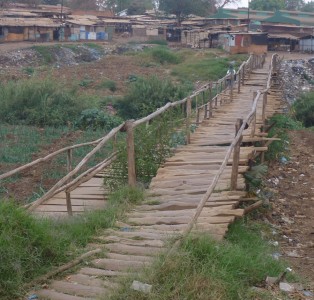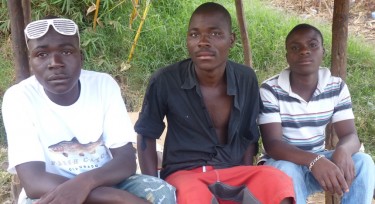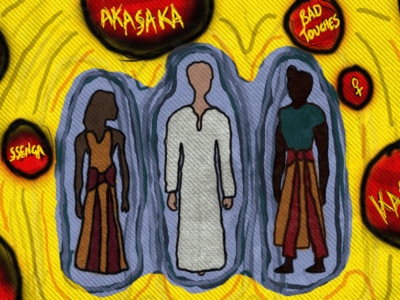As the world's population reaches 7 billion at the end of October, one sign that Lilongwe, Malawi's capital, is growing rapidly are the numbers of people that flock to the city's markets. Two of such markets are on opposite sides of the Lilongwe River in this city of just over 1 million. One market sells vegetables and farm produce, the other clothing.
Four years ago, going from one market to the other meant taking a circuitous path along the riverbank, crossing the Lilongwe Bridge, and then walking back on the other side. Today, there are bridges connecting the two markets, but they are not conventional bridges. They have been constructed by hand using locally-sourced wood.

A hand-made bridge connecting two markets across the Lilongwe river. By Steve Sharra (CC-BY)
The bridge pictured on the right was constructed by a team of seven young men, and it now provides them with a livelihood. They take turns manning the bridge, from as early as 6am to as late as 7pm when darkness falls and the markets close.
The proceeds of the day's bridge-crossing go into the pocket of whoever is on shift. From his earnings, Samuel Mbewe told me he had opened a grocery store.
Their constructors collect tolls, currently at K10.00 (US$0.06) per person crossing.
A local solution to joblessness and urbanization
On Sunday October 2, 2011, I found Samuel Mbewe and Kayen Kayanka, standing guard at their bridge. In the three years that they have owned the bridge they have never counted how many people cross the bridge per day. But Samuel told me their earnings range from MK9,000 (US$54) on a slow day, to MK25,000 (US$150) on a good day.
At MK10 person, that's between 900 and 2,500 people crossing the bridge every day. But it's only an estimate, since he says some people pay only K5, while others don't pay anything at all, such as friends and colleagues.

At work on a Lilongwe river bridge, Samuel Mbewe and Kayen Kayanka with friend. By Steve Sharra (CC-BY)
The bridges are not for the lightheaded, or someone with vertigo. First timers take slow steps, while experienced crossers walk as if they were in Air Jordan basketball sneakers.
A Swiss blogger, Janique Racine, wrote in 2007 about being frightened to death upon crossing a swaying bridge. She said:
Of course you don’t want to look down but you have to because your foot might get stuck in the empty spaces!
There are other hazards as well. The Lilongwe River overflows during the rainy season. The bridges get damaged in the floods, but they are rebuilt once the rainy season is over. In January this year a man drowned trying to cross.
In July this year, the young men (there are no women thus far) organized themselves into a “bridges union”. They agreed each bridge should contribute K200 (US$1.20) per day to a shared pool. That translates into MK803,000 (US$4,808) per year. The aim of the union is to support members in times of death or bereavement. I asked about future investment plans with the savings, but they had none, as yet.







1 comment